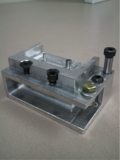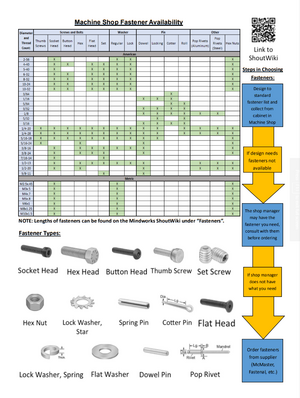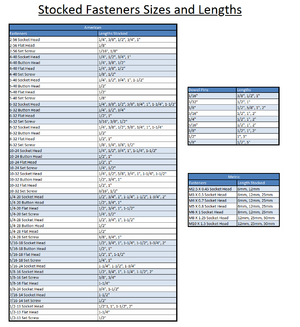Fasteners
Jump to navigation
Jump to search
Fasteners are used to fix different objects together.
For other types of fasteners not listed, go to http://www.mcmaster.com
Pictures and descriptions derived from McMaster-Carr.
Useful links:
Procedure[edit | edit source]
- Principle
- The purpose of a Standard Operating Procedure (SOP) for SOPs is to provide Instructions for the user to best accomplish an individual task.
- The purpose of the associated SOP Manual is to ensure accurate Selection of local fasteners in the University of Idaho ME Machine shop
- Steps to fastener selection
- Define need of fastener, including FBD, and calculations (Bolt calculation
information can be found in “Mechanical Engineering Design” by Shigley and
Mischke.
- This is the text used in ME 325.
- Identify correct type of fastener to fit previously defined needs.
- Find closest available size to meet calculated requirements
- Inventory List available at http://mindworks.shoutwiki.com/wiki/File:2015L_fasteners_Poster.png
- Check with project advisor and shop manager before ordering fasteners that are not stocked.
- Draw or Locate 3-D model of fastener
- Suggest using McMaster-Carr website to locate 3-D model of Fastener https://www.mcmaster.com/
- Ensure part file is named to match UIdaho inventory NOT McMaster-Carr inventory.
- Ensure BOM includes UIdaho inventory name NOT McMaster-Carr Inventory name
- Acquire fasteners chosen from inventory within Machine shop.
- If you have any questions with regards to Fastener selection your Project advisor, and shop manager are great resources.
- http://mindworks.shoutwiki.com/wiki/Fasteners
- http://mindworks.shoutwiki.com/wiki/File:2015L_fasteners_Poster.png
- https://www.mcmaster.com/
- List of stocked fastener types, sizes, and their uses available below
(Check the shop first before planning on using any of these fasteners, there's a possibility stock may be running low on certain bolts or stock has changed)
- Appendices
Screws and Bolts[edit | edit source]
*Not available in the machine shop
| Flat-Head Socket Cap Screw |  |
Designed for high-tensile strength applications and flush mounting operations. Common in Tools and Dies. Requires a countersink to be flush with the surface. See Drilling and Tapping for more information. |
| Button-Head Socket Cap Screw |  |
Wide bearing surface. Offers a finished appearance. Designed for light fastening operations. |
| Socket-Head Cap Screw |  |
High-strength tension applications. Designed for clamping assemblies. Reliable and Durable. Requires a counterbore to be flush with the surface. See How to Use Counterbores for more information. |
| Hex-Head Cap Screw |  |
General Purpose Fastening. |
| Set Screw |  |
Designed to hold objects in place, such as a pulley on an axle. Often used in conjunction with a key. |
| Thumb Screw |  |
Adjustable by hand. Use in applications where hand tightening is adequate. |
| Machine Screw* |  |
Available in different head styles. Use in lower strength applications. |
| Carriage Bolt* |  |
Neck keeps bolt from turning when tightening a nut. Use in applications where the bolt cannot be easily accessed after assembly. |
| Threaded Rod* |  |
Alternative to a bolt. Used to anchor elements to surfaces, mount wheels and pulleys, etc. |
Nuts[edit | edit source]
Washers[edit | edit source]
Pins[edit | edit source]
Other[edit | edit source]
| Rivets | Permanently hold two pieces of material together. Punch through a pre-drilled hole. |








